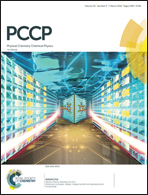Hydrogen bonding effect between active site and protein environment on catalysis performance in H2-producing [NiFe] hydrogenases†
Abstract
The interaction between the active site and the surrounding protein environment plays a fundamental role in the hydrogen evolution reaction (HER) in [NiFe] hydrogenases. Our density functional theory (DFT) findings demonstrate that the reaction Gibbs free energy required for the rate determining step decreases by 7.1 kcal mol−1 when the surrounding protein environment is taken into account, which is chiefly due to free energy decreases for the two H+/e− addition steps (the so-called Ni-SIa to I1, and Ni-C to Ni-R), being the largest thermodynamic impediments of the whole reaction. The variety of hydrogen bonds (H-bonds) between the amino acids and the active site is hypothesised to be the main reason for such stability: H-bonds not only work as electrostatic attractive forces that influence the charge redistribution, but more importantly, they act as an electron ‘pull’ taking electrons from the active site towards the amino acids. Moreover, the electron ‘pull’ effect through H-bonds via the S− in cysteine residues shows a larger influence on the energy profile than that via the CN− ligands on Fe.
![Graphical abstract: Hydrogen bonding effect between active site and protein environment on catalysis performance in H2-producing [NiFe] hydrogenases](/en/Image/Get?imageInfo.ImageType=GA&imageInfo.ImageIdentifier.ManuscriptID=C7CP07685A&imageInfo.ImageIdentifier.Year=2018)


 Please wait while we load your content...
Please wait while we load your content...